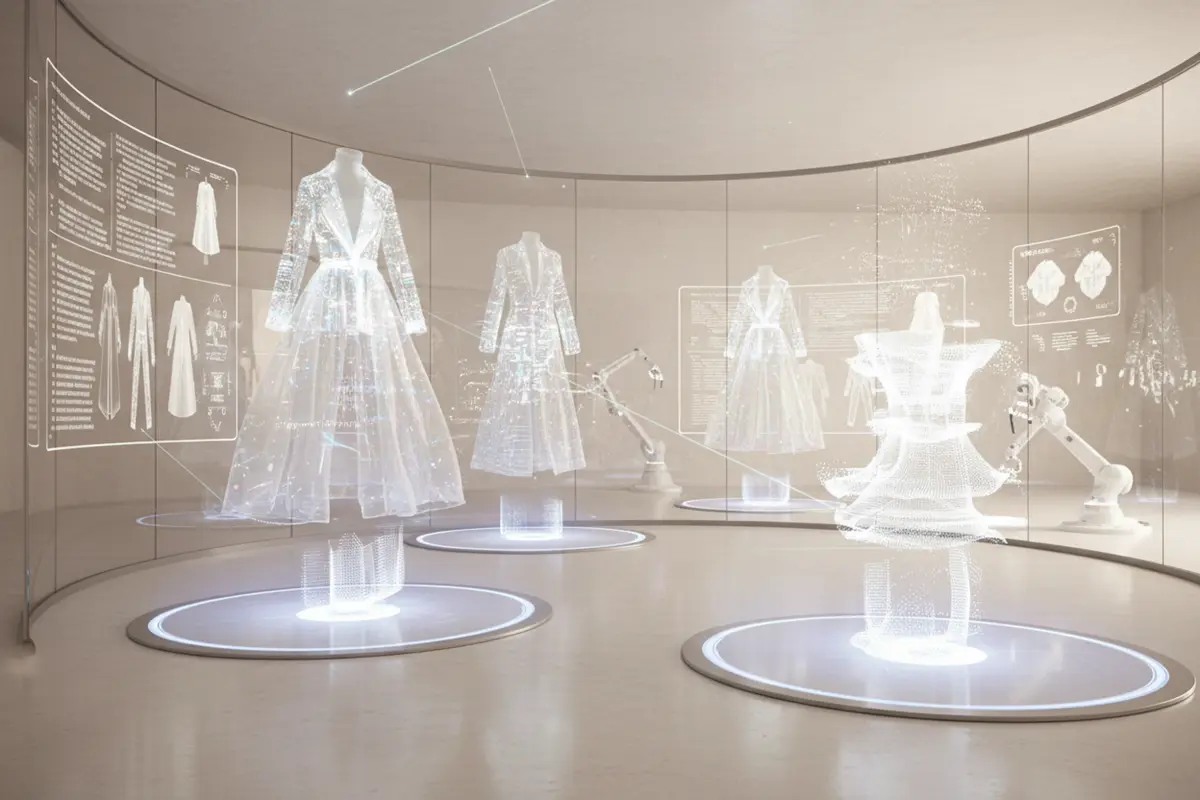
Introduction: The New Era of Fashion Tech
The fashion industry evolves at an incredible speed. Designers, developers, and product teams now rely on digital technology to build collections with more accuracy and less waste. The technology of fashion no longer supports only single tasks — it powers the entire fashion business from concept to retail. Many brands shift from traditional methods to advanced technology because they want increased efficiency, clearer workflows, supply chain transparency, and new capabilities that help them stay competitive. In recent years, the pace of technological adoption in the fashion industry has accelerated, driving rapid transformation across the sector.
Fashion tech transforms how clothes are imagined, created, and delivered to the world. The rise of digital clothing, smart textiles, wearable technology, and AR-based retail tools proves how strong the relationship between fashion and tech has become. Fashion brands now work inside connected digital ecosystems that support creativity while reducing the environmental impact of outdated manufacturing processes. Other industries are also experiencing significant digital transformation, with sectors like technology and textiles embracing innovation and sustainability alongside fashion.
The integration of PLM, 3D design, artificial intelligence, and augmented reality helps businesses in the fashion industry leverage technology to innovate and stay competitive by responding to the latest trends in real time. The fashion industry now sees technology as a core strategic asset. Advanced technology gives brands a competitive edge, supports sustainable practices, and improves the entire design process. These innovations help many brands grow, scale, and thrive in a fast-moving world.
What “Fashion Tech” Really Means Today
Fashion technology influences every step of creating fashion products, from ideation to final production. It impacts how fashion designers brainstorm, sketch, model, test, and communicate ideas. It also changes how consumers discover, try, and buy clothes. The rise of virtual worlds, wearable tech, smart fabrics, and 3D printing proves that fashion and tech now move in complete alignment.
A. Design & Creative Technology
- 3D fashion design tools help designers create styles faster than ever.
- Digital moodboards support early phases in the design process.
- AI-powered inspiration tools help study customer data and discover the latest trends.
- Virtual fashion tools allow teams to build digital clothing for virtual worlds.
For example, 3D printing is used to rapidly prototype new garment designs, allowing designers to test shapes and materials before full production.
These innovations help fashion brands explore ideas without using raw materials. They support creative freedom while reducing the environmental impact of early concepts.
B. Product Development Technology
- PLM platforms store product data in one place.
- Digital tech packs replace inconsistent spreadsheets.
- Material libraries organize smart textiles, fabric qualities, trims, and digital elements.
- Data sharing between teams and suppliers happens in real time.
These tools reduce challenges in communication and help many brands reduce waste during product development.
C. Manufacturing Technology
- Automated cutting tools deliver precise and fast manufacturing processes.
- 3D printing supports rapid prototyping.
- Smart factories use built in sensors and connected machinery.
- Supply chain platforms track real time data across each production step.
Digital tools and platforms are also improving transparency and efficiency across complex supply chains in the fashion industry, enabling better traceability, responsible sourcing, and increased consumer trust.
Factories now adopt advanced technology to reduce waste, support fair wages, and monitor environmental impact.
D. Retail & Consumer Technology
- Virtual reality enhances digital shopping experiences.
- Augmented reality AR and virtual try ons help consumers choose the right clothes.
- Customer data enables personalized recommendations.
- Wearable gadgets and wearable technology monitor heart rate, fitness, and health data.
The internet enables seamless connectivity between smart devices, wearable technology, and retail platforms, allowing for real-time data exchange and innovative features that enhance the overall customer experience.
These tools elevate the customer experience and help the average consumer shop with confidence.
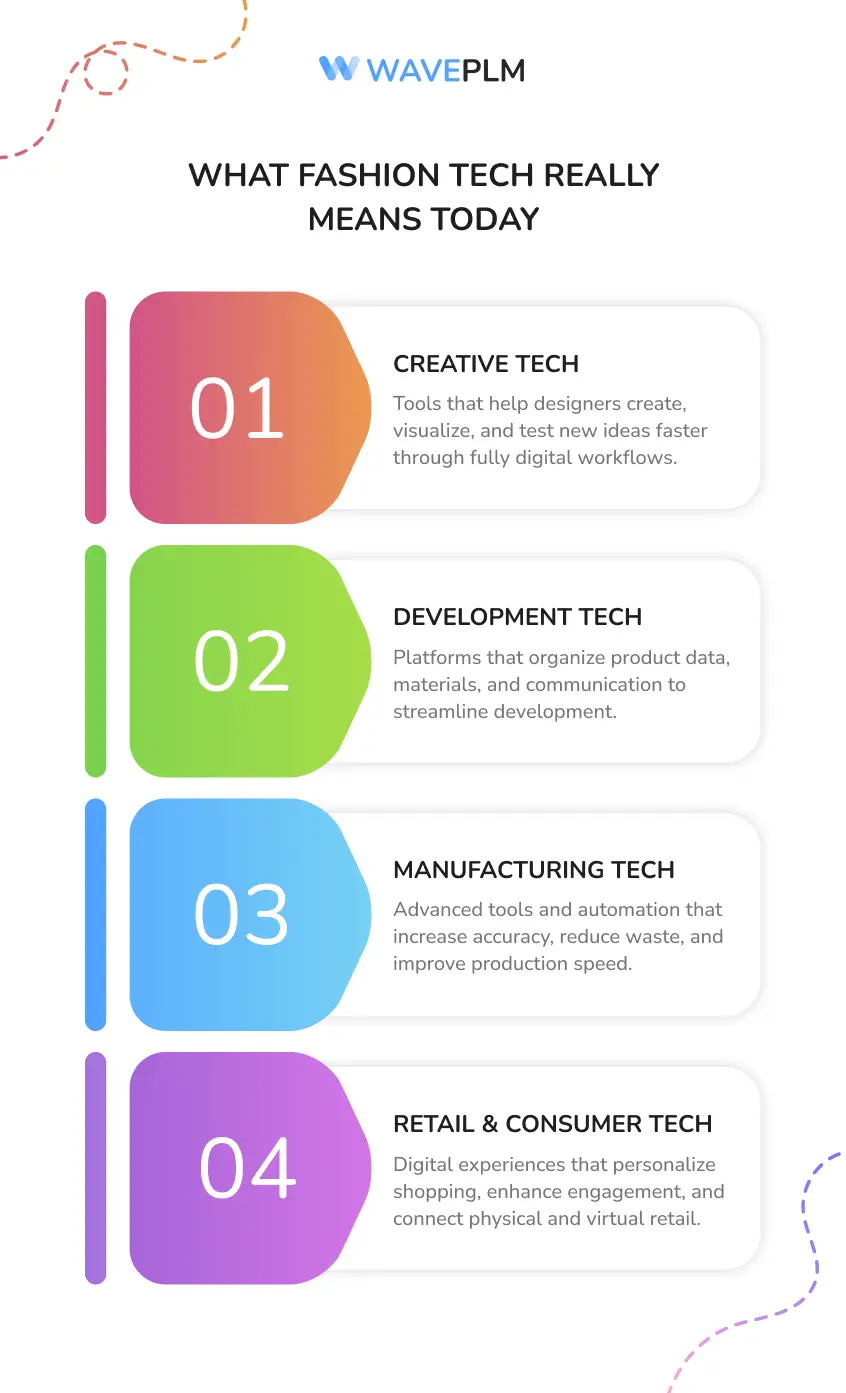
Why Brands Invest in Fashion and Technology
Fashion and tech operate as one unified engine inside the modern industry. Brands invest in fashion technology because it delivers practical solutions to long-standing challenges.
The adoption of new technology, such as AR, VR, and immersive digital tools, is also a major driver for investment in fashion tech, enabling innovative experiences like virtual try-ons and digital fashion shows.
Key Motivations
- Faster ideas reach consumers.
- Fewer physical samples reduce waste.
- Artificial intelligence AI and machine learning improve demand forecasting.
- Blockchain technology creates supply chain transparency.
- Digital capabilities improve new innovations in sustainability.
The fashion industry continues to adopt cutting edge technologies because they help many brands stay ahead of competitors and maintain a competitive edge.
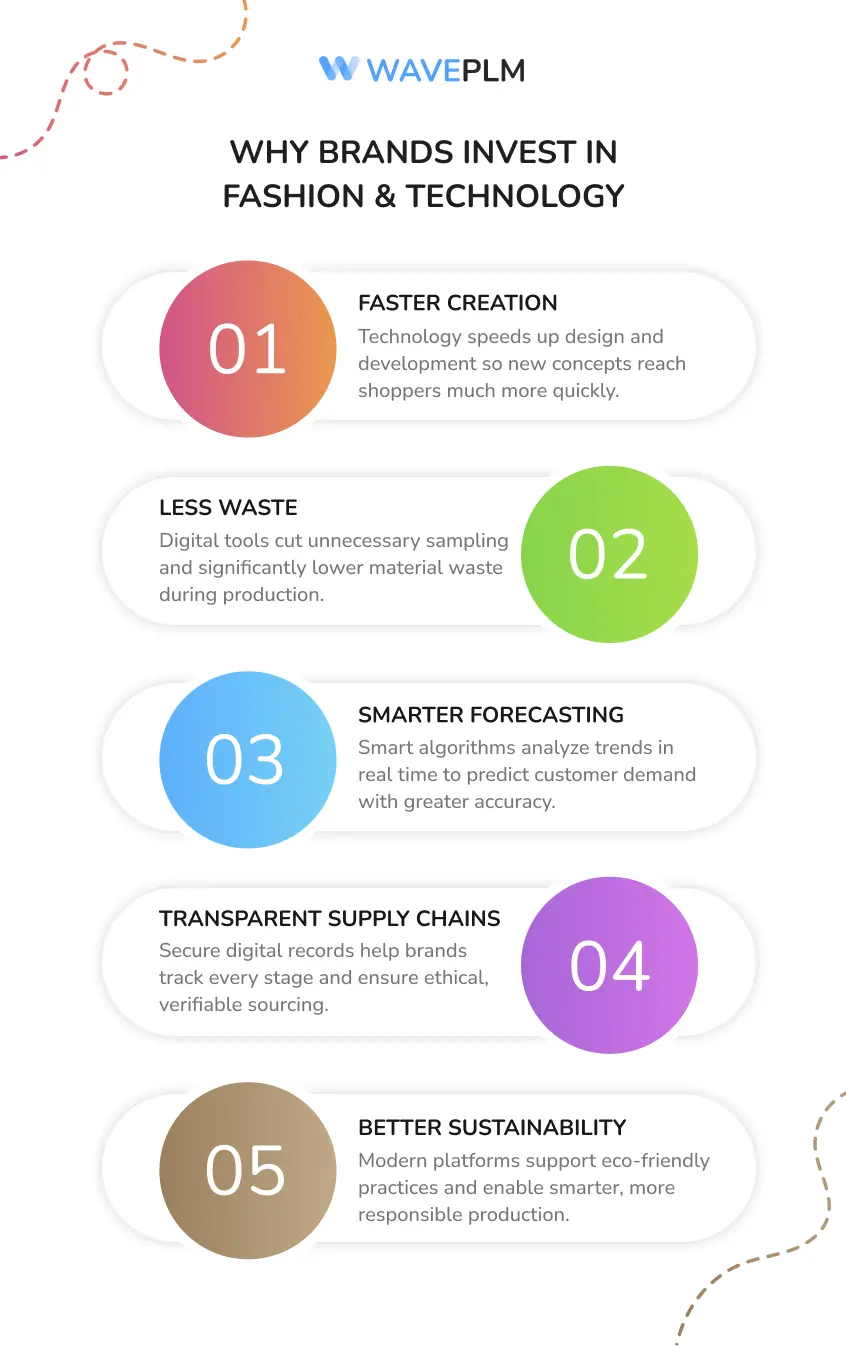
Core Technologies Changing Fashion Today
Here are the most influential tools shaping the world of fashion.
1. 3D Digital Prototyping
3D tools help designers create virtual fashion samples and test fit, style, and color. This reduces waste and supports sustainable practices.
2. Smart Materials and Fabric Databases
Smart textiles, conductive threads, and smart fabrics store powerful data for teams. Libraries sync with PLM, allowing clear cross-team communication.
3. AI Tools for Trend Forecasting
Artificial intelligence studies patterns in real time. It supports designers who want to create clothes that reflect the latest trends.
4. PLM (Product Lifecycle Management)
PLM sits at the center of fashion tech. It manages data, connects teams, reduces errors, and accelerates the entire design process.
5. AR/VR Technology
Virtual reality and augmented reality enhance buying experiences and support virtual fitting rooms.
6. Robotics and Automation
Factories adopt robots, automation, 3D printing, and digital tools to limit manual errors and reduce waste from manufacturing processes.
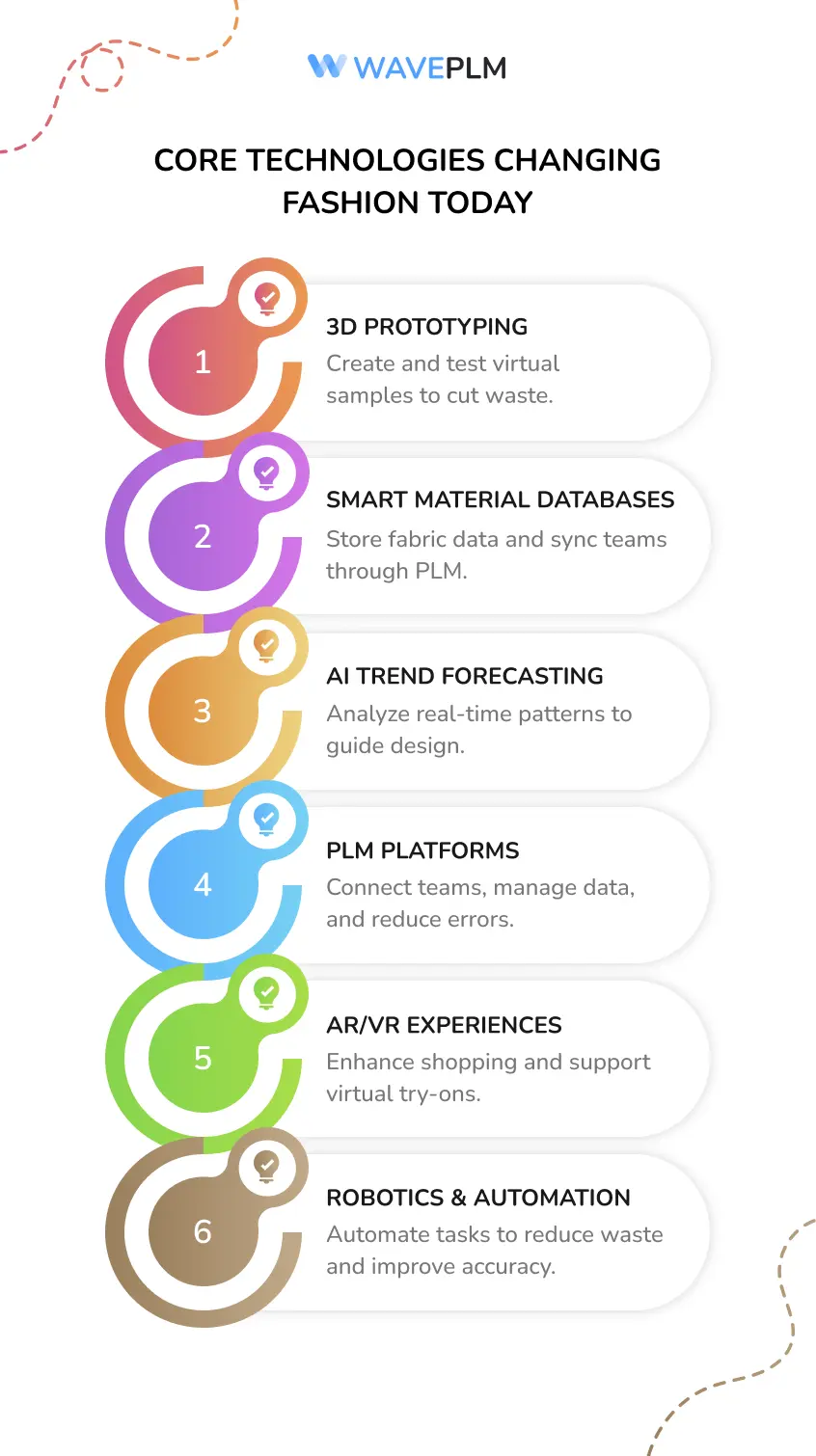
Fashion + Tech in Action: A Full Workflow
The modern workflow combines creative thinking with advanced technology and real time data. Below is a complete view of how fashion and tech work together.
Step 1: Inspiration
AI moodboards, trend algorithms, and digital research tools give designers insight into the latest trends.
Step 2: Design
Designers use 3D fashion design tools to create silhouettes, textures, and details.
Step 3: Tech Design
PLM systems hold measurements, materials, digital elements, stitching details, and technical specs.
Step 4: Sampling
Virtual fashion prototypes limit the use of raw materials and reduce waste.
Step 5: Manufacturing
Factories rely on automation, smart machinery, and real time data for increased efficiency.
Step 6: Logistics
Supply chain tools offer transparency, support fair wages, and track goods across the world.
Step 7: Retail
AR-powered virtual try ons and personalized recommendations elevate the customer experience.
Table: Fashion Technology Tools by Stage
|
Stage |
Tools |
Benefit |
|---|---|---|
|
Inspiration |
AI boards, trend tools, customer data |
Faster ideas |
|
Design |
3D design, virtual fashion, smart textiles |
Fewer samples |
|
Development |
PLM, material libraries, digital tech packs |
Clear data |
|
Sampling |
Virtual prototypes, 3D printing |
Less waste |
|
Manufacturing |
Robotics, automation, sensors |
Increased efficiency |
|
Retail |
AR, VR, virtual fitting rooms |
Better customer experience |
How PLM Connects All Fashion Technologies
PLM acts as the central platform for the entire fashion business. It stores data, organises communication, and integrates with every major fashion technology solution. Designers, developers, suppliers, and manufacturers rely on PLM to keep information aligned.
PLM improves real-time data flow and helps minimise errors. It supports many brands that want great strides in innovation. It connects 3D tools, ERP systems, sourcing platforms, and supply chain tools. This connection helps reduce waste, improve communication, and support sustainable practices.
Trends That Shape the Future of Fashion Tech
Below are major trends shaping the future of the global fashion industry. For example, the British fashion label Stitch Fix utilizes AI-driven solutions for wardrobe planning and personalization, demonstrating how innovative brands are leveraging technology to enhance customer experiences.
Hyper-Personalized Design
AI and machine learning personalize collections using real customer data.
On-Demand Manufacturing
Factories produce small batches with less waste and more flexibility.
Digital-Only Fashion
Designers create digital clothing for virtual worlds, games, and immersive experiences.
Automated Micro-Factories
Machines and automation support local production with reduced environmental impact.
Blockchain Transparency
Blockchain technology helps track raw materials and support supply chain transparency.
Wearable Technology
Fitness trackers, conductive threads, and built in sensors help monitor heart rate and improve daily lives.
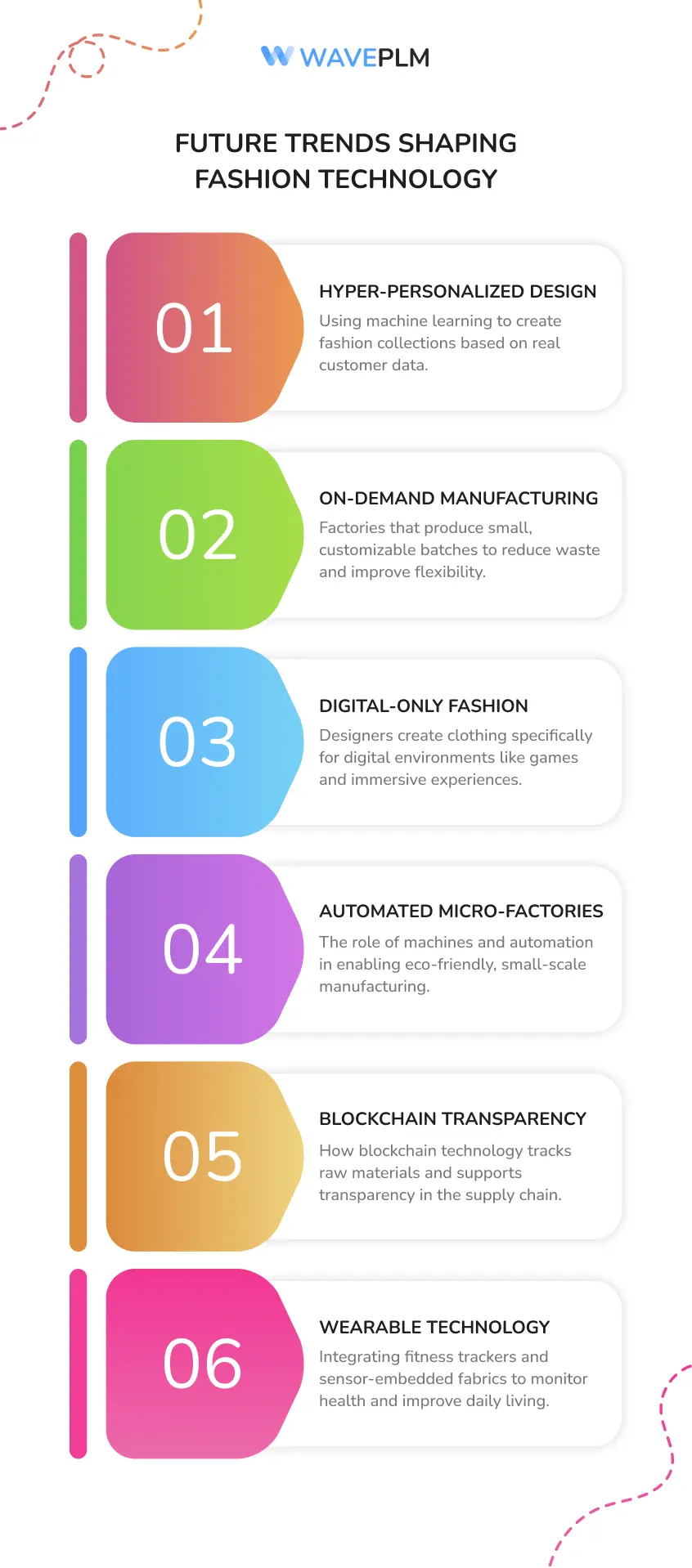
Template: Fashion Tech Strategy Checklist
Here is a fully filled-in, visible, expanded Fashion Tech Strategy Checklist.
Each point includes clear explanation and action steps.
✔ Strategy Checks
- 3D Tools Integrated Into the Design Process
The team uses CLO3D, Browzwear, and digital prototypes for every new silhouette. Virtual samples replace early physical samples. - Digital Material Library Fully Built
Fabric qualities, trims, smart textiles, conductive threads, color standards, and wash codes are stored in one searchable library. - PLM as the Single Source of Truth
All BOMs, tech packs, measurements, and costings are now in PLM. No spreadsheets or scattered files. - AR Virtual Try-Ons Live in E-Commerce
Shoppers can view garments in 3D, rotate them, and test fit through augmented reality. - AI Trend Forecasting Active
AI tools scan customer data, global fashion cycles, social signals, and runway images to predict demand and trending styles. - Supply Chain Transparency Mapped With Blockchain
Every step — raw materials, dyeing, stitching, packing — is recorded on a blockchain ledger. Consumers can scan QR codes to view the entire chain. - Environmental Impact Dashboard Running
Digital tools report CO₂ output, water usage, textile waste, recycling rates, and chemical impact per product. - Automation Installed in Key Manufacturing Stages
Automated cutting, digital pattern projection, sensor-monitored stitching machines, and robotic arms reduce manual error. - Virtual Fashion Used for Sampling + Marketing
Digital-only garments appear in lookbooks, e-commerce previews, and campaigns for virtual worlds. - VR & AR Customer Journeys Implemented
Virtual fitting rooms, VR brand showrooms, and immersive collection walkthroughs enhance the customer experience. - Data Privacy Framework in Place
Customer data, wearable tech health data, and internal business data are encrypted, regulated, and protected.
Conclusion: Technology Shapes the Future of Fashion
The world of fashion shifts toward new innovations and cutting-edge technologies. Digital technology supports designers, factories, business teams, and consumers. Many fashion brands invest in advanced tools because they want to create faster, reduce challenges, and stay relevant.
Fashion technology drives transformation across the entire industry. It supports creativity, efficiency, and long-term success. The future belongs to brands that adopt advanced technology, rethink traditional methods, and build smarter workflows.

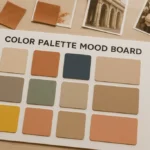
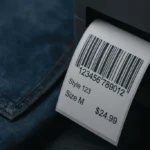


Leave a Reply